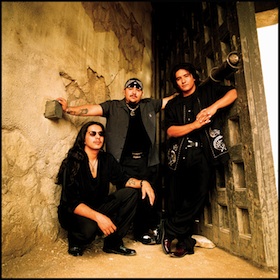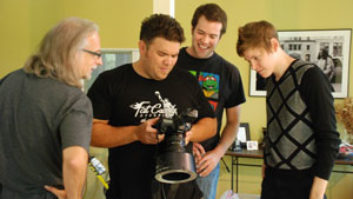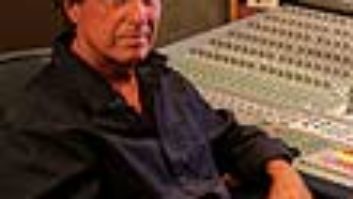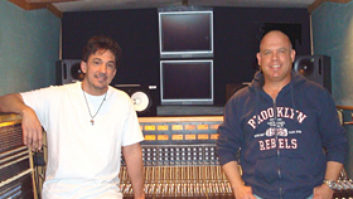
Los Lonely Boys, from left: Henry, Ringo and Jojo Garza
When Los Lonely Boys, a trio of very musical brothers, exploded out of the small city of San Angelo, Texas, in 2004 with the hit single “Heaven” from their eponymous debut album, many wondered, “What can they do for an encore?” After all, rare is the band that hits the jackpot first time out: “Heaven” rocketed to Number One on Billboard’s Adult Contemporary chart, made the Top 20 on the pop charts and won a Grammy; the album sold more than 2 million copies. The appealing and versatile Garza brothers—guitarist Henry, bassist Jojo and drummer Ringo, all in their mid-20s when the album hit—turned up everywhere, it seems, for the next couple of years, including TV awards shows and on other people’s albums (such as Santana’s All That I Am and the Amnesty International John Lennon tribute album, Instant Karma).
And while their subsequent albums haven’t made the splash of their debut, Los Lonely Boys continue to tour successfully worldwide while further developing their craft onstage and in the studio. Drawing from a broad range of musical styles, from rock to soul to folk to various “Texican” traditions (including tejano and norteño), and united by the brothers’ patented harmonies (which have always reminded me of Los Lobos), the group has carved out a unique niche in the mainstream music world and managed to stay true to themselves along the way; never an easy feat.

Front row, from left: Steve Chadie, Jojo Garza and Ringo Garza. Back row, from left: Henry Garza, Frenchie Smith and Kush.
Their latest studio album—their fourth, not counting a Christmas set and their fine 2009 covers EP, 1969 (on which they covered Santana, The Beatles, The Doors, Tony Joe White and Buddy Holly)—is called Rockpango, and it’s a solid collection of 11 tunes that really shows their maturity as a band. There’s a good dose of heavy rock riffs, with Henry Garza getting a chance to flash his Hendrix/Stevie Ray side on the exciting title cut, while dipping into more of a Clapton bag on the bluesy “Porn Star.” There’s funky clavinet on a couple of tracks, a wonderfully breezy acoustic romp called “Fly Away,” sumptuous ballads accompanied by strings, a strange but cool spoken-sung number called “16 Monkeys” and catchy riffs throughout that recall everyone from The Beatles to Cream, while still hewing to the Los Lonely Boys sound.
I>Rockpango is their first album where they have been the sole producers, but to keep things in their comfort zone, they once again worked with engineer Steve Chadie (pronounced “shady”), who cut the group’s first two albums (Los Lonely Boys and Sacred), plus 1969. They recorded in their favorite room, Willie Nelson’s Pedernales Studio, where Chadie is on staff.
“That studio feels like home to us,” comments Jojo Garza. “When we actually build our own studio [in San Angelo], it’s going to be a lot like Willie’s place. I told Chadie we’re going to clone him to make sure we have somebody good behind the board at all times.”
Chadie originally came to Pedernales (located in the Hill Country 30 miles west of Austin) as an intern in 1995, “and my first day, Willie Nelson and the Beach Boys were there. I met Brian Wilson, and I thought, ‘Yeah, I could enjoy doing this!’” he says with a chuckle. He learned the ropes assisting under Larry Greenhill and Stuart Sullivan (who ran Pedernales’ sister facility, Arlyn Studios, in Austin), and after Greenhill left in 2003, Chadie took on more lead engineering duties—like that first Los Lonely Boys album.
Actually, Chadie first encountered and recorded Los Lonely Boys three years earlier. “I think the first time I ever saw them was in 2000. They were at one of Willie’s Fourth of July Picnics [concert extravaganza], and they came on Willie’s bus, and we were like, ‘Who are these kids, man?’ And they sat down with these acoustic guitars and they played, and our jaws just dropped. Wow! After that, I did an acoustic demo with them, and I also assisted and did some Pro Tools work on a record with them, but that never came out. It had some of the songs that turned up on the first album, but they weren’t happy with it so we basically re-did it later; and then there were some other songs that they wrote in between, of course.”

Jojo and Henry Garza at Pedernales Studio
Chadie says recording the first album was very straight-forward. “It was totally different than the way they work now because, as they say, you have your whole life to write your first record, so they had the songs together and then we made the whole thing—recorded, mixed and gone—in 28 days.”
Then and now, the band recorded live in the studio as a three-piece. Pedernales’ large main room has a high, irregular ceiling and wooden floors, and the control room is based around an SSL 4048 G+ console and a 1970s 80 Series Neve that Chadie describes as “like a huge sidecar.”
Having a hit is always thrilling, but it also usually leads to greater expectations from the record company suits, and such was the case with Los Lonely Boys and Epic Records. As Chadie notes, “When you make a hit record, the label then wants the same thing over and over, and the band took a lot of heat for not giving them ‘Heaven, Part II.’ And you can’t really blame them—they’re a business, not a band. I understood both sides, but being a musician first I understood what these cats wanted to do. They wanted to progress and keep making original-sounding music. I’ve heard some callous things said about that second record—‘What’s with that accordion? Why aren’t they playing the game?’—but I think it’s a great record. I respect them for making the music they wanted to make. And they’re still that way.”
Adds Jojo Garza, “We write what we see, what we feel, what we hear and what we experience in this world and in our personal lives. That’s what it is to us—it’s write what you feel.”
When the band went into the studio to make that second album, they didn’t have most of the songs written, and it was during those sessions that they adopted the writing/recording technique they favor today (and used on Rockpango). Chadie notes, “I would say the process is they have basic ideas, they come in and vamp and jam on them, and I run the machine. They come in, play off these ideas, figure out structures, and somehow it morphs into songs. And the music is usually written before the lyrics—at least it was on this new album. If people came in and looked at it, they’d probably think it was inefficient, but it’s really not—it’s the way they work. It’s not a structured thing.”
Chadie cites “Porn Star” and “16 Monkeys” as new tracks that evolved that way, and Jojo Garza adds, “‘Love in My Veins’ is another that was written completely in the studio. On that one, the first lick was written on piano and then it went to Henry and me messing around, and then Ringo got involved and it turned into this really cool tune. Sometimes we might have some lyrics we had written down a long time ago, and we’ll go, ‘Hey, that might work for this.’ But most times it will start with a guitar riff or a piano riff, and we’ll go from there.”
To capture the trio’s sound at Pedernales, Chadie says, “I like to put Ringo’s drums where the ceiling is highest. I put up two pairs of room mics and then a mono room mic, and gate them and blend them.” For the close-in mic, he’ll use a stereo AKG 422 in a mid/side configuration; then the next set back will be Neumann U87s or U47s; and then the most distant mics are U47s or U48s “because they’re kind of smooth. A lot of people use ribbon mics for room mics, but I like the 47s. I’ll also stick a mono [AKG] 414 in the hallway and gate that—that’s strictly for snare. On the kit itself, I put [Shure] 57s on the snare, [Sennheiser] 421s on the toms, [Electro-Voice] RE-20 inside the kick and a FET 47 on the outside. Overheads are some kind of Neumann, usually KM100s.
“The guitar rig is 57s and 421s,” he continues. “Henry’s got a great setup—we run a Marshall and a Fender in tandem, four channels. I used to sum ’em back in the days of tape; now we’ve got so many channels I don’t bother summing them. I’ll pan those hard. We also had an Echoplex on the Marshall and we matched it up with some delay on the Fender later on.” Traditionally, Henry Garza has played a Strat almost exclusively “but on this album, he was busting out some [Gibson] ES335 and Les Paul. Four or five songs are Gibson.
“On bass I use a Demeter tube DI and Joey’s got a huge SWR rig with an 8×10 cabinet and I put a [AKG] D12 on that. Even though we’ll sometimes put [Henry Garza’s] amps off in another room, Joey wants the bass amp in the room with him so I baffle it off, about 10 feet from the drum kit. There’s a significant amount of bass bleed in the room mics, but I’ve decided not to worry about it—it’s part of the sound.”
Chadie will use a couple of Shure 58s for scratch vocals, though he notes they often don’t have the lyrics finished when they’re laying down the instruments, so the singers might just be humming along or singing fragments. Keeper vocals happen in one of the studio’s iso booths. “Joey likes to have four passes to work off of,” Chadie says. “We’ll do a comp, listen to the comp and go back in and take care of anything we need to. Usually we get a good comp, though. These guys can sing, man! It’s so nice not to have to tune the vocals.” Chadie uses a U47 going through the Neve’s mic pre’s (1079s) and a Tube-Tech compressor.
Although the actual recording time for Rockpango was fairly minimal, the project spread out over several months when Jojo Garza had to lay low after a growth was discovered on his vocal cords and he underwent (successful) surgery. Two other studios in addition to Pedernales saw some work on the project: Strings were cut at Church House Studio in Austin by David Boyle, and some B-3 and vocals for two songs were done at Wire Studio in Austin by Chadie.
The engineer mixed the album in the box at his home. He has a number of plug-ins he employs, including the Bomb Factory 1176, Trillium Lane Labs’ TL Space reverb, PSPaudioware delays and compression, and FilterBank EQs.
What changes has Chadie seen in his 10 years working with Los Lonely Boys? “They’ve gotten a lot tighter. I mean, they were tight to begin with, but it just seems like all the years on the road have really pulled their sound together. They’re playing like one three-part person. It’s amazing!”




